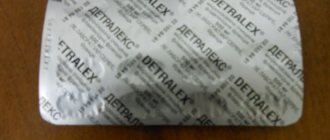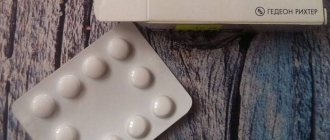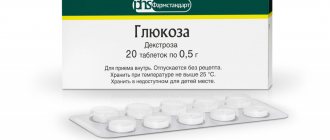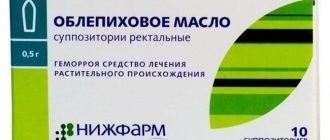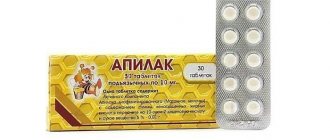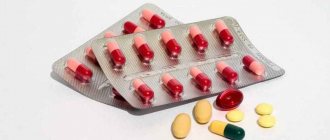Release form and composition
- solution for infusion 5%: colorless transparent liquid [100, 250, 500 or 1000 ml in plastic containers, 50 or 60 pcs. (100 ml), 30 or 36 pcs. (250 ml), 20 or 24 pcs. (500 ml), 10 or 12 pcs. (1000 ml) in separate protective bags, which are packed in cardboard boxes along with an appropriate number of instructions for use];
- solution for infusion 10%: colorless transparent liquid (500 ml in plastic containers, 20 or 24 pieces in separate protective bags, which are packed in cardboard boxes along with the appropriate number of instructions for use).
Active substance: dextrose monohydrate – 5.5 g (corresponding to 5 g of anhydrous dextrose) or 11 g (corresponding to 10 g of anhydrous dextrose).
Excipient: water for injection – up to 100 ml.
Drug interactions
Glucose is compatible with other drugs; moreover, it is often dripped into a vein in combination with something else to increase efficiency and more targeted treatment. Such combinations are often used in medicine.
Glucose with ascorbic acid (AA) is used for large blood losses and to eliminate infections. This compound can support health and immunity during severe stress, and since AK contains a lot of vitamin C, doctors use this combination against vitamin deficiencies. Glucose with novocaine is prescribed for poisoning with various substances (from alcohol to other medications) and toxicosis, as well as for the prevention of pathologies that can develop after blood transfusion
This is very important because post-transfusion complications are deadly. Glucose and sodium chloride are used to normalize the volume of extracellular fluid during surgical operations. This solution can also replenish sodium deficiency. Combination with potassium chloride helps prevent arrhythmia during myocardial infarction, as well as restore potassium balance after intoxication.
Contraindications
- hyperlactatemia;
- hyperglycemia;
- hypersensitivity to the active substance;
- dextrose intolerance;
- hyperosmolar coma;
- allergy to foods that contain corn.
Additionally for 5% glucose solution: uncompensated diabetes mellitus.
Additionally for 10% glucose solution:
- decompensated diabetes mellitus and diabetes insipidus;
- extracellular hyperhydration or hypervolemia and hemodilution;
- severe renal failure (with anuria or oliguria);
- decompensated heart failure;
- liver cirrhosis with ascites, generalized edema (including pulmonary and cerebral edema).
Infusion of dextrose solutions 5% and 10% is contraindicated within 24 hours after a head injury. You also need to take into account contraindications for medicinal substances added to the dextrose solution.
Can be used during pregnancy and lactation according to indications.
Daily norm
To nourish brain cells, red blood cells, striated muscles and provide the body with energy, a person needs to eat “his” individual norm. To calculate it, multiply your actual body weight by a factor of 2.6. The resulting value is your body’s daily requirement for the monosaccharide.
At the same time, for knowledge workers (office employees) performing computational and planning operations, athletes and people experiencing heavy physical activity, the daily norm should be increased, since these operations require more energy.
The need for glucose decreases with a sedentary lifestyle, a tendency to diabetes, and excess weight. In this case, the body will use fat reserves rather than easily digestible saccharide to produce energy.
Remember, glucose in moderate doses is a medicine and “fuel” for internal organs and systems. Excessive consumption of sweets turns it into poison, turning its beneficial properties into harm.
Directions for use and dosage
Glucose is administered intravenously. The concentration and dose of the drug is determined depending on the age, condition and weight of the patient. The concentration of dextrose in the blood should be carefully monitored.
Usually the drug is administered into a central or peripheral vein, taking into account the osmolarity of the injected solution. The administration of hyperosmolar solutions can cause venous irritation and phlebitis. Whenever possible, when using all parenteral solutions, it is recommended to use filters in the solution supply line of infusion systems.
Recommended use for adults:
- as a source of carbohydrates and for isotopic extracellular dehydration: with a body weight of about 70 kg - from 500 to 3000 ml per day;
- for diluting parenterally administered drugs (as a base solution): from 50 to 250 ml per dose of administered drug.
Recommended use for children (including newborns):
- as a source of carbohydrates and for isotopic extracellular dehydration: with body weight from 0 to 10 kg - 100 ml/kg per day, with body weight from 10 to 20 kg - 1000 ml + 50 ml for each kg over 10 kg per day, with body weight from 20 kg – 1500 ml + 20 ml for each kg over 20 kg per day;
- for diluting parenterally administered drugs (as a base solution): from 50 to 100 ml per dose of administered drug.
In addition, a 10% glucose solution is used to treat and prevent moderate hypoglycemia and for rehydration in case of fluid loss.
Maximum daily doses are determined individually depending on age and total body weight and range from 5 mg/kg/minute (for adult patients) to 10–18 mg/kg/minute (for children, including newborns).
The rate of administration of the solution is selected depending on the clinical condition of the patient. To avoid hyperglycemia, the threshold for dextrose utilization in the body should not be exceeded, therefore the maximum rate of drug administration in adult patients should not exceed 5 mg/kg/minute.
Recommended initial rate of administration for children depending on age:
- premature and full-term newborns – 10–18 mg/kg/min;
- from 1 to 23 months – 9–18 mg/kg/min;
- from 2 to 11 years – 7–14 mg/kg/min;
- from 12 to 18 years – 7–8.5 mg/kg/min.
Interaction with other drugs
Glucose solution 40% should not be administered in the same syringe with hexamethylenetetramine, since glucose is a strong oxidizing agent. It is not recommended to mix in one syringe with alkaline solutions: with general anesthetics and sleeping pills, as their activity decreases, solutions of alkaloids; inactivates streptomycin, reduces the effectiveness of nystatin.
Under the influence of thiazide diuretics and furosemide, glucose tolerance decreases. Insulin promotes the entry of glucose into peripheral tissues, stimulates the formation of glycogen, the synthesis of proteins and fatty acids. Glucose solution reduces the toxic effect of pyrazinamide on the liver. The administration of a large volume of glucose solution contributes to the development of hypokalemia, which increases the toxicity of simultaneously used digitalis preparations.
Side effects
The incidence of side effects cannot be determined based on the available data.
- immune system: hypersensitivity*, anaphylactic reactions*;
- metabolism and nutrition: hypervolemia, hypokalemia, hypomagnesemia, dehydration, hyperglycemia, hypophosphatemia, electrolyte imbalance, hemodilution;
- skin and subcutaneous tissue: rash, increased sweating;
- vessels: phlebitis, venous thrombosis;
- kidneys and urinary tract: polyuria;
- pathological condition of the injection site and general disorders: infection at the injection site, chills*, phlebitis, fever*, local soreness, irritation at the injection site, extravasation at the injection site, fever, tremor, febrile reactions, thrombophlebitis;
- laboratory and instrumental data: glucosuria.
*These side effects may occur in patients with corn allergies. They may also manifest themselves as other types of symptoms, such as cyanosis, hypotension, bronchospasm, angioedema, and itching.
Pharmacological properties
Pharmacodynamics. Glucose provides substrate replenishment of energy expenditure. When hypertonic solutions are injected into a vein, intravascular osmotic pressure increases, the flow of fluid from tissues into the blood increases, metabolic processes accelerate, the antitoxic function of the liver improves, the contractile activity of the heart muscle increases, and diuresis increases. When a hypertonic glucose solution is administered, redox processes are enhanced and glycogen deposition in the liver is activated.
Pharmacokinetics. After intravenous administration, glucose enters the organs and tissues through the bloodstream, where it is included in metabolic processes. Glucose reserves are stored in the cells of many tissues in the form of glycogen. Entering the process of glycolysis, glucose is metabolized to pyruvate or lactate; under aerobic conditions, pyruvate is completely metabolized to carbon dioxide and water, producing energy in the form of ATP. The end products of complete oxidation of glucose are excreted by the lungs and kidneys. Pharmaceutical characteristics
Basic physical and chemical properties: transparent, colorless or slightly yellowish liquid.
special instructions
Cases of infusion reactions, including anaphylactoid/anaphylactic reactions, and hypersensitivity reactions have been reported when using dextrose solutions. If symptoms or signs of a hypersensitivity reaction develop, the infusion should be stopped immediately. Depending on the clinical indicators, appropriate therapeutic measures should be taken.
Glucose should not be used if the patient is allergic to corn and corn products.
Depending on the patient's clinical condition, metabolism (dextrose utilization threshold), volume and rate of infusion, intravenous dextrose may lead to electrolyte imbalances (namely: hypomagnesemia, hypokalemia, hypophosphatemia, hyponatremia, overhydration/hypervolemia and, for example, congestive states, in including pulmonary edema and hyperemia), hypoosmolarity, hyperosmolarity, dehydration and osmotic diuresis.
Hypoosmotic hyponatremia can cause headache, nausea, seizures, lethargy, coma, cerebral edema, and death.
Severe symptoms of hyponatremic encephalopathy require emergency medical attention.
An increased risk of hypoosmotic hyponatremia is observed in children, women, the elderly, postoperative patients, and individuals with psychogenic polydipsia.
The risk of developing encephalopathy, as a complication of hypoosmotic hyponatremia, is higher in children and adolescents under 16 years of age, premenopausal women, patients with diseases of the central nervous system, and patients with hypoxemia.
Periodic laboratory testing is required to monitor changes in fluid balance, acid-base balance, and electrolyte concentrations during prolonged parenteral therapy and, if necessary, to evaluate the dose used or the patient's condition.
Glucose is prescribed with extreme caution to patients with an increased risk of water and electrolyte imbalance, which is aggravated by increased free water load, hyperglycemia, and the need for insulin.
Clinical indicators of the patient's condition are the basis for preventive and corrective measures.
Under close supervision, large volume infusions are performed in patients with pulmonary, cardiac or renal failure and overhydration.
When using a large dose of dextrose or long-term use, it is necessary to monitor the concentration of potassium in the blood plasma and, if necessary, prescribe potassium supplements to avoid hypokalemia.
To prevent hyperglycemia and hyperosmolar syndrome caused by rapid administration of dextrose solutions, it is necessary to control the infusion rate (it must be below the threshold for dextrose utilization in the patient's body). If the concentration of dextrose in the blood is elevated, the infusion rate should be reduced or insulin administration should be prescribed.
With caution, intravenous administration of Glucose solutions is carried out in patients with severe exhaustion, severe traumatic brain injury (administration of Glucose solutions is contraindicated in the first day after a head injury), thiamine deficiency (including in patients with chronic alcoholism), reduced tolerance to dextrose (to for example, in conditions such as diabetes mellitus, sepsis, shock and trauma, renal failure), water and electrolyte imbalances, acute ischemic stroke, and in newborns.
In severely malnourished patients, refeeding may lead to the development of refeeding syndrome, which is characterized by increased intracellular concentrations of magnesium, potassium and phosphorus due to increased anabolic processes. Fluid retention and thiamine deficiency are also possible. To avoid the development of these complications, it is necessary to conduct careful and regular monitoring and increase the intake of nutrients gradually, avoiding excess nutrition.
In pediatrics, the rate and volume of infusions are determined by the attending physician experienced in the field of intravenous infusion therapy in children and depend on the body weight, age, metabolism and clinical condition of the child, as well as concomitant medications.
Neonates, especially those born prematurely or at low birth weight, are at high risk of developing hypoglycemia and hyperglycemia and require more careful monitoring of blood dextrose concentrations. Hypoglycemia can cause prolonged seizures, coma, and brain damage in newborns. Hyperglycemia is associated with delayed fungal and bacterial infectious diseases, necrotizing enterocolitis, intraventricular hemorrhage, retinopathy of prematurity, bronchopulmonary dysplasia, increased length of hospital stay, and death. Particular attention must be paid to monitoring intravenous infusion devices and other drug administration equipment to avoid potentially fatal overdose in neonates.
Children, both newborns and older children, are at increased risk of developing hyponatremic encephalopathy and hypoosmotic hyponatremia. When using Glucose solutions, they require constant careful monitoring of the concentration of electrolytes in the blood plasma. Rapid correction of hypoosmotic hyponatremia is potentially dangerous due to the risk of serious neurological complications.
When using dextrose solution in elderly patients, one should take into account the presence of cardiac diseases, liver diseases, kidney diseases, as well as concomitant drug therapy.
Glucose solutions are contraindicated to be administered before, simultaneously with, or after blood transfusion through the same infusion equipment, since pseudoagglutination and hemolysis may occur.
There is no data on the effect of the drug on the ability to drive vehicles and complex mechanisms.
Properties of glucose and its effect on the body
Glucose has general strengthening properties, which is good for conditions characterized by depletion at the physical level. It is also used as a detoxifier, that is, it promotes the removal of toxic substances. This is due to the ability of glucose to activate the corresponding abilities in the liver. Dextrose itself reduces toxins in body fluids by affecting the frequency and volume of urination. Replenishing the fluid balance of the human body is also attributed to the properties of glucose.
The body needs to constantly consume dextrose to supply energy to neurons in the brain, as well as blood cells and muscles. For the body to function without failure, the amount of glucose in the blood must vary from 3.5 to 5.0 mmol/l. This number is regulated hormonally, by insulin and glucagon.
Causes of hypoglycemia
The main causes of hypoglycemia in diabetes mellitus are an overdose of insulin (or sulfonylurea derivatives), insufficient intake of carbohydrates from food, delaying or skipping meals and excessive exercise. Hypoglycemia can be triggered by alcohol if the patient does not eat on time.
Insufficient carbohydrate intake
When a patient is prescribed insulin therapy, the selection of insulin doses is based on the amount of carbohydrates that the patient usually eats. Therefore, if he eats less than usual (for example, due to lack of appetite or because he wants to lose weight), or does not eat on time, the insulin dose will be excessive. With intensive insulin therapy, patients are taught to independently reduce the dose of insulin administered before meals, and if the patient does not have this skill, then it is likely that he will develop hypoglycemia. If the patient intends to continue to eat little, the doctor should reconsider the dose of insulin or oral hypoglycemic agents (sulfonylurea derivatives and meglitinides). If a meal is delayed for any reason, advise replacing it with a carbohydrate-containing snack, and if the patient is taking repaglinide or nateglinide, the drug can be delayed until food is available.
Insulin overdose
Hypoglycemia can be caused by accidentally administering too much insulin. When dialing insulin, extreme precision must be observed. You should also discuss any planned changes in diet or physical activity with your doctor so that your insulin dose can be adjusted.
Sometimes the development of hypoglycemia is promoted by the wrong choice of place for insulin injection, for example, when injecting insulin into an area that will be involved during physical activity. So, if you inject into the thigh before jogging, during exercise the blood flow in it will increase and the absorption of insulin will accelerate. The same effect occurs if insulin is injected into the muscle instead of subcutaneous tissue.
Physical exercise
During exercise, muscles consume glucose, causing blood levels to drop, especially if they were normal or low before exercise. Therefore, in order to avoid hypoglycemia before intense physical activity, patients are recommended to take additional carbohydrates. Hypoglycemia can be triggered not only by playing sports, but also by, say, gardening, cleaning, shopping, or rearranging furniture. Before such exercise, you need to eat well (or take up physical activity immediately after eating, when glucose levels are highest).
Alcohol consumption
A person with diabetes can drink moderate amounts of alcohol, provided that he does so with meals. Alcohol consumed on an empty stomach can cause hypoglycemia because it inhibits gluco-neogenesis in the liver, which is usually increased during fasting, to prevent a decrease in blood glucose levels. If a diabetic patient receiving insulin or sulfonylurea derivatives drinks alcohol on an empty stomach and does not eat in the next few hours, this can lead to hypoglycemia.
Overdose
If the norms recommended by the instructions are exceeded, side effects are observed more often. When taking excessive doses of dextrose and ascorbic acid simultaneously, headaches, increased excitability, damage to the gastrointestinal mucosa, bloating, and rarely insomnia may occur. In case of an overdose of the drug, it is possible: a decrease in insulin synthesis, the onset of hyperglycemia; decreased appetite. In such conditions, it is necessary to stop taking dextrose and consult a doctor for symptomatic treatment.
Analogs
You can buy analogues of tableted glucose in pharmacies. Their active component is dextrose monohydrate, so the drugs have similar properties. Such means include:
- Glucose Bief;
- Glucose Brown;
- Glucose Vial;
- Glucose-E;
- Glucosteril;
- Dextrose;
- Dextrose monohydrate;
- Dextrose Vial;
- Licadex PF dextrose monohydrate.
What are the consequences
A sharp increase in blood sugar levels, as well as a drop in this indicator, can have a detrimental effect on the baby’s health. What are the symptoms of glucose imbalance? When there is a shortage:
- increased activity;
- anxiety;
- desire to eat sweets;
- heavy sweating;
- dizziness;
- pale skin;
- fainting.
All these symptoms disappear instantly if you give the baby something sweet or administer intravenous glucose. These conditions are dangerous because they can degenerate into a hypoglycemic coma, which in turn can lead to the death of the patient.
Symptoms of high blood sugar in a child include:
- weakness;
- headache;
- cold extremities;
- dry mouth;
- extreme thirst;
- itchy skin;
- Digestive problems.
Treatment of diabetes
Quite often, with a hypoglycemic coma that accompanies diabetes mellitus, you can normalize glucose levels by taking insulin tablets. You can overcome hypoglycemic conditions by taking dextrose. This active substance is a dextrorotatory optical isomer of glucose, which is produced in the form of chewable tablets in various flavors. It is this type of glucose that is necessary to nourish the human brain and muscles. Based on the fact that dextrose consists of only one molecule, it is not digested in the intestines, but begins to be immediately absorbed by the body, right in the oral cavity. The choice of the drug itself and its dosage for diabetes mellitus is prescribed exclusively by an endocrinologist for each patient individually.
All drugs containing insulin, produced in tablet form, can be of two types - short-acting and long-acting. The advantage of using short-acting drugs is the simple storage method: there is no need to maintain a special temperature regime, as when storing insulin injections. Long-acting insulin tablets tend to have a hypoglycemic effect on the body for 12 hours from the moment of their use. The long-acting drug is also stored at room temperature without losing its properties.
Very often, glucose is used in case of poisoning with narcotic substances, alcohol, aniline, carbon monoxide and other substances that cause intoxication of the body. Despite the great benefits of glucose and its irreplaceability, it is still not always possible to take it, since there are the following contraindications:
- hyperglycemia;
- hypersensitivity;
- overhydration;
- problems with glucose utilization;
- impaired blood circulation in the lungs and brain;
- hyperosmolar coma;
- swelling of internal organs.
When insulin enters the body after taking the tablets, left ventricular failure or hypervolemia may develop.
Quite often, if glucose tablets are used incorrectly, serious side effects can occur, such as hyperglycemia and loss of appetite. As a rule, side effects occur after the administration of an insulin solution; with tablets, this process occurs extremely rarely.
To avoid the unpleasant consequences of such treatment for diabetes mellitus or hypoglycemic conditions, you should strictly follow the drug dosage regimen prescribed by your doctor. The tablets should not be swallowed, they must be dissolved or chewed, doing this an hour before meals, since glucose tends to reduce appetite. This substance is excreted from the body by the kidneys, no later than a day later.
Low blood sugar in a child
The treatment algorithm for low blood sugar in children is the same as for adults. However, there are nuances, which are discussed below. Many worried parents mistake their child's glucose readings for hypoglycemia, which are actually normal. In such situations, they worry and fuss in vain, bothering doctors. Worst of all, they can force a diabetic child to eat carbohydrates that are bad for him. This worsens the course of the disease.
For adults, normal blood sugar is 4.0-5.5 mmol/l. For children from birth to adolescence, the normal range is 0.6 mmol/L lower. It is 3.4-4.9 mmol/l. A child's glucose level of 2.9-3.2 mmol/l is not hypoglycemia at all. Nothing needs to be done, except in cases of insulin overdose. If it drops to 2.8 mmol/l and below, without panic, you need to give the child a little glucose tablets to raise the sugar to about 3.5 mmol/l.
Also watch a video about blood sugar levels for children. In this video, Dr. Bernstein discusses glucose goals and how to achieve them with the father of a child with type 1 diabetes. Compare with the recommendations of your endocrinologist, as well as domestic diabetic forums.
Young children often have levels below 2.8 mmol/L after they actively run and play. At these same moments, acetone may appear in the urine. All this is not a problem, but the norm. Feed your diabetic child approved foods based on appetite. Drink plenty of fluids. There is no need to give glucose tablets in such situations. They are only needed in case of insulin overdose. Moreover, you don’t need sweets, flour products and other carbohydrates.
How to reduce the risk of hypoglycemia in a diabetic child?
The only real possible cause of low blood sugar in children is an overdose of insulin. Unfortunately, it is very difficult to resist injecting a diabetic child with excess insulin at first. In children who are not overweight until adolescence, the sensitivity to this hormone is very high. Get used to the fact that your child needs extremely low doses of insulin, almost homeopathic. Glucose should be given in similarly low doses in case of hypoglycemia.
Learn the method for calculating the dosages of short-term and ultra-fast insulin before meals
Please note that for children the calculated starting dose for the first injection should be reduced by 8 times. Then it is slowly increased based on the results of previous injections
Learn to dilute insulin. Parents of diabetic children cannot do without this. Don't expect to control diabetes without insulin at all. During colds and other infectious diseases, injections will have to be given in any case. So keep insulin and glucose tablets handy.
Do I need to inject insulin if my sugar is low?
There is no simple answer to this question. The dose of short or ultra-short insulin, which is injected before meals, consists of a food bolus and a correction bolus. A food bolus is designed to absorb carbohydrates and proteins eaten. A correction bolus may be needed to bring elevated blood sugar levels back to normal. If the blood glucose level is low, then a collection bolus is not required. You can even reduce your food bolus. For more information, read the article “Selecting a dose of short-term and ultra-fast insulin before meals.”
